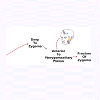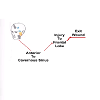Journal of Oral Biology
Download PDF
Research Article
*Address for Correspondence: Tanya Sehgal, LECOM School of Dental Medicine, 4800 Lakewood Ranch Blvd. Bradenton, FL, E-mail: sehgaltanya01@gmail.com
Citation: Itkin A, Sehgal T. Review of Phineas Gage’s Oral and Maxillofacial Injuries. J Oral Bio. 2017; 4(1): 3.
Copyright © 2017 Sehgal, et al. This is an open access article distributed under the Creative Commons Attribution License, which permits unrestricted use, distribution, and reproduction in any medium, provided the original work is properly cited.
Journal of Oral Biology | ISSN: 2377-987X | Volume: 4, Issue: 1
Submission: 08 February, 2017 | Accepted: 02 March, 2017 | Published: 07 March, 2017
3) The rod continued into the infratemporal fossa, anterior to the pterygoid plexus and then entered the posterior orbit. The optic nerveremains intact however there is ptosis of Gage’s eye indicating a damaged cranial nerve III.
4) It penetrated the cranial fossa through the frontal bone: Its trajectory was anterior to the cavernous sinus.
Review of Phineas Gage’s Oral and Maxillofacial Injuries
Allen Itkin and Tanya Sehgal**
- LECOM School of Dental Medicine, 4800 Lakewood Ranch Blvd. Bradenton, FL
*Address for Correspondence: Tanya Sehgal, LECOM School of Dental Medicine, 4800 Lakewood Ranch Blvd. Bradenton, FL, E-mail: sehgaltanya01@gmail.com
Citation: Itkin A, Sehgal T. Review of Phineas Gage’s Oral and Maxillofacial Injuries. J Oral Bio. 2017; 4(1): 3.
Copyright © 2017 Sehgal, et al. This is an open access article distributed under the Creative Commons Attribution License, which permits unrestricted use, distribution, and reproduction in any medium, provided the original work is properly cited.
Journal of Oral Biology | ISSN: 2377-987X | Volume: 4, Issue: 1
Submission: 08 February, 2017 | Accepted: 02 March, 2017 | Published: 07 March, 2017
Abstract
A large iron rod weighing 13.25 pounds passed through Gage’s head and surprisingly he lived 12 years with this injury. Though Gage survived this injury, his personality changed drastically. “Gage was no longer Gage”, he changed from an even tempered man to being “fitful, irreverent, indulging at times in the grossest profanity”. These events helped establish the relationship between personality and the frontal region of the brain.However, his maxillofacial injuries are seldom noted. In this study, we reviewed previous texts and journal articles to enable a mapping of the trajectory of the iron rod through his maxillofacial region.
The iron rod first pierced through his left cheek, lateral to the mandible, anterior to the masseter muscle, and anterior to the parotid gland, therefore not penetrating the oral cavity. The zygomatic bone was then fractured and laterally displaced. The rod continued into the infratemporal fossa, apparently anterior to the pterygoid plexus and then entered the posterior orbit. It penetrated the cranial fossa through the frontal bone: Its trajectory was anterior to the cavernous sinus. It then penetrated the orbital portion of the frontal lobe before exiting the skull.
Although Phineas Gage’s brain injuries are important, it is equally important to look at his maxillofacial injuries. The iron rod missed some major venous plexuses that could have possibly caused fatal bleeding.
Introduction
In 1848 Phineas Gage was a railroad foreman, an iron rod that he was using to pack explosive powder blew up [1,2]. The iron rod was 43 inches long, 1.25 inches in diameter and weighed 13.25 pounds shot upward and penetrated Phineas Gages’ skull. Luckily Phineas Gage survived this injury and he lived 12 years with this injury. However after this accident “Gage was no longer Gage.” Phineas Gage used to be an even tempered, and he changed to “uttering the grossest profanity”, and showed “little deference for his fellows.”Phineas Gage became the most famous patient of neuroscience because he showed a link between brain injury and personality.
Methods
Multiple journal articles, and books were analyzed in order to determine what structures the iron rod could have possibly penetrated. Some of the information provided was indicated by journal articles, however most of the pathway was indicated by projecting the possible structures that the iron rod penetrated. We have constructed a review outline to define the injuries that he suffered.Results and Discussion
Discussion
The projected trajectory is:1) The iron rod first pierced his left cheek, lateral to the mandible, and anterior to the masseter muscle, and parotid gland, it may have lacerated the buccinator muscle, penetrating the oral cavity. We can’t confirm that it knocked out a maxillary molar.3) The rod continued into the infratemporal fossa, anterior to the pterygoid plexus and then entered the posterior orbit. The optic nerveremains intact however there is ptosis of Gage’s eye indicating a damaged cranial nerve III.
4) It penetrated the cranial fossa through the frontal bone: Its trajectory was anterior to the cavernous sinus.
Conclusion
Phineas Gage is a major landmark case in neuroscience. It is surprising how Gage was able to survive this accident and live 12 years later. Phineas Gage’s oral and maxillofacial injuries were rarely noted. It is amazing how the iron rod penetrated the oral cavity, and caused limited intraoral damage. If the iron rod’s path was different and it penetrated the pterygoid plexuses or the cavernous sinus Phineas Gage could have bled to death.References
- Harlow JM (1848) Passage of an iron rod through the head. Boston Med Surg J 39: 389-393.
- Fleischman J (2002) Phineas Gage: A gruesome but true story about brain science. Houghton Mifflin Company.
- Harlow JM (1993) Recovery from the passage of an iron bar through the head. History Psychiatry 4: 274-281.
- Macmillan M (2000) An odd kind of fame: Stories of Phineas Gage. MIT Press, Cambridge, pp.576.
- Ratiu P, Talos IF (2004) Images in clinical medicine: The tale of Phineas Gage digitally remastered. N Engl J Med 351: e21.
- Van Horn JD, Irimia A, Torgerson CM, Chambers MC, Kikinis R, et al. (2012) Mapping connectivity camage in the case of Phineas Gage. PLoS One 7: e37454.
- (2016) The Phineas Gage story. The University of Akron. Phineas Gage's Story.






